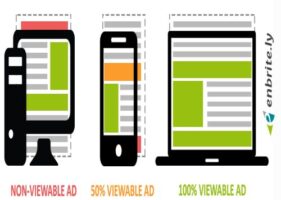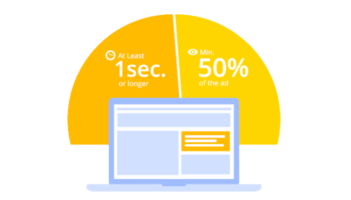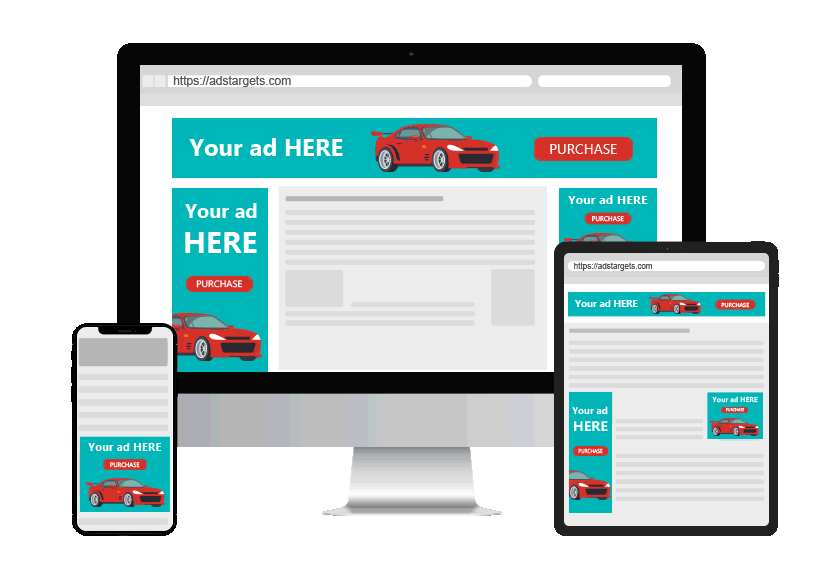One of the main objectives of online advertising is to gain reasonable ad viewability while building a solid Brand Awareness and converting your ad audience to paying customers.
Display advertising is, in fact, a typical form of online advertising that makes use of spaces specifically made available by publishers and website owners for the placement of ad formats, including banner ads.
The main purpose of a banner is to capture the attention of an internet audience surfing the net who find themselves visiting the contents of those pages and encourage them to interact with the ad itself.


Google’s Display Network helps companies reach users as they browse their favourite websites, giving them the ability to strategically display advertising banners with different attractive ad formats.
For display campaigns to be successful, however, it is not just the number of ads that is important, but rather the Ad viewability, i.e. their ability to be seen by users and to impress them.
So let’s now find out together what Ad viewability means and what tools Google provides to measure it.
Table of Contents
ToggleWhat is Ad Viewability
Viewability is a metric that is used to measure how much your display ads such as banner ads are seen by your target audience.
Today, in fact, advertisers want to know if their banner ads are watched and for publishers it is no longer sufficient to display a certain number of times the banners, perhaps in places that are not visible on the pages.
But it becomes necessary to carefully study the positioning, the size, the loading times, the colours of the advertised banners. Elements that together form the Ad viewability.


In fact, within a web page there can be multiple advertising formats, but do they all have the same effectiveness? Absolutely not.
Depending on their positioning within the page (and not only), but the formats can also, in fact, be more or less effective, and therefore have a different value for an advertiser.
This depends on the Ad view rate, their capacity to be seen. The more a format is visible within a page, the more it has the chance to be noticed and clicked on, and the more positive the results will be.
HOW TO MEASURE AD VIEWABILITY
But when? technically, there is there anything like Google ad viewability? There are conflicting opinions on this definition, but the reference normally taken as standard is the one created by IAB ad viewability guideline, according to which there is Google Ad view rate when:
- In the case of a display ad, 50% of its pixels are visible on the browser window for at least 1 second continuously;
- In the case of a large display ad (larger than 242,000 pixels), 30% of the pixels are visible on the browser window for at least 1 second continuously;
- In the case of an in-stream video ad, 50% of the pixels are visible on the browser window for at least 2 seconds continuously.


Considering these references, you can easily understand how, in the normal navigation of a user, some formats are “naturally” more visible than others.
For example, if we divide a page into “above the fold” (the upper half of the page) and “below the fold” (the lower half), according to Google 68% of the “above” impressions are generally visible, compared to 40% of the “below” ones.
But in reality, there are also other elements that can contribute to Ad view, for example, the device used (pc or mobile) or the shape of the ad: Google tells us that normally vertical formats are more visible than horizontal ones.
GOOGLE ACTIVE VIEW
There are various tools on the market for measuring Ad viewability. Google, for example, offers one, free of charge and already integrated into all its advertising platforms.
It is called “ACTIVE VIEW” and allows you to measure in real-time whether an ad is visible or not by a user, based on the direct measurement of each impression delivered.


As defined by Google itself, Active View is a free, transparent, and effortless solution, accredited by the Media Rating Council (MRC), that measures Ad viewability across the web and in apps.
Active View is integrated into all Google’s advertising products so you can measure the visibility of each type of advertisement used, without any sampling.
Active View is, therefore, the perfect tool to track the Ad views.
Active View refers to the most common technical methods (previously analyzed) for evaluating the Ad viewability.
Consequently, the two most important factors measured through Active View are (a) what percentage of an ad appears in a visible space on the screen and (b) how long that part of the ad remains visible.
In this way, advertisers can assess the degree of ad visibility and try to take action accordingly.
ACTIVE VIEW METRICS
Google Active View provides a range of metrics to take into account for the efficient measurement of the Ad views. These are the following:
#1. Measurable Impressions: An impression is counted every time an ad is posted. “Measurable impressions” means the number of times an ad has been posted to positions within websites or apps that have been measurable through Active View.
This metric helps you understand the frequency with which an advertisement has been posted to positions that can be measured by Active View.
#2. Visible impressions: This metric indicates the number of times your ad’s impressions have been considered visible.
An ad is counted as visible if at least 50% of its surface area is visible for at least 1 second in the case of display ads or at least 2 seconds in the case of video ads.
This metric allows you to understand how often an ad has been posted in locations where it was visible to users.
#3. Visible Rate: The visibility rate of your ad. This is the percentage of time during which the ad was displayed and was visible on sites or apps that support Active View.
This percentage represents an estimate of the number of measurable impressions that were actually visible to potential customers.
#4. Measurable Rate: The measurable impressions out of the total impressions represent the percentage of impressions measured by Active View as a percentage of the total.
Total impressions include both measurable and non-measurable impressions.
This metric allows you to know the frequency with which an advertisement has been published in positions measurable by Active View.
#5. Non-measurable impressions: This means that the ad was posted on sites, apps, or devices that we’re unable to capture information about Active View’s visibility.
This does not mean that the ad was or was not displayed – it simply means that the ad was posted on sites, apps, or devices that Active View was unable to measure.
#6. Non-visible impressions: This means that the ad has not been shown for at least 50% of its surface for at least 1 second in the case of display ads or at least 2 seconds in the case of video ads.
This metric allows you to know the number of times the ad has been posted in a position not visible to users.
4 TIPS TO IMPROVE AD VIEWABILITY
In order to optimize Ad viewability, Google provides a number of very important tips:
#1. First of all, you have to build the web pages taking care to place the advertising formats in areas that are naturally more visible, such as the “above the fold” area.
An alternative is to insert Sticky ads, which remain visible by accompanying the user in scrolling the page (but in this case it is better not to exceed, otherwise the user’s experience will worsen as well as risk violating the rules of the Google AdSense program);
#2. Since the same format may have a different Ad viewability depending on the device used, it is a good practice, moreover, to develop a page design that is mobile responsive, i.e. that adapts to navigation from various devices (PC, smartphone or tablet) resizing proportionally;
#3. And don’t forget the “loading speed” element. It is important to try to avoid that the page has graphic elements that are too heavy, or latency in the delivery of campaigns, because the user may be pushed to leave it before the ads appear.
In this regard, an applicable strategy is Lazy Loading, also called Smart Loading, when a campaign is delivered only when necessary.
When a user enters a site, for example, it may not be necessary for “below the fold” ads to be delivered before they scroll through the page;
#4. Dedicated video section: The integration of a dedicated video section into your site or app can direct traffic directly to your videos; this generally means that viewers are more likely to watch the videos, and when viewers are more likely to watch the videos, they are more likely to see the ads within them as well.
Why Ad View rate is important
After analyzing every aspect of Ad viewability and how Google operates to analyze the visibility itself, we can ask ourselves why the great importance of Ad view in the world of web marketing.
In the past, media buyers used to measure the success of their campaigns on the basis of a metric, the click-through rate, given by the ratio between the number of ads delivered and the number of clicks made on those ads.
Therefore, it was fundamentally important for advertisers’ ROI that the campaign was delivered. However, as the concept of ad visibility began to spread, the attention of companies gradually shifted from the number of impressions delivered to the number of ads actually viewed, thus establishing new methods of measuring campaign effectiveness.
This is why, today, it is essential for a publisher to make its advertising offer attractive by optimizing the Ad viewability.


By taking care of the Ad viewability and maximizing the number of viewable impressions on your site, it will be possible:
- Make the additional inventory eligible for brand advertisers who purchase viewable impressions on the Google Display Network;
- Reveal high and low areas of viewability on your site so you can focus on increasing the rate of Ad viewability;
- Help you understand how likely an ad is to be clicked.
Conclusion
In this article, you have had the opportunity to understand the meaning of Ad viewability and how this element is crucial to the success of any display and online marketing campaign today.
As you have noticed, Google provides a variety of valid tools to measure Ad viewability such as “Active View”, and it is necessary to follow a series of precise metrics to evaluate it.
Your goal must, therefore, be to focus more on the visual quality of the ads, their ability to be attractive to the user, and therefore be easily visible.
By using Active View and following the advice in the article, you will be able to improve the Ad viewability.
We hope this article has been helpful to you. You are always welcome back and visit us anytime!
See you soon!





